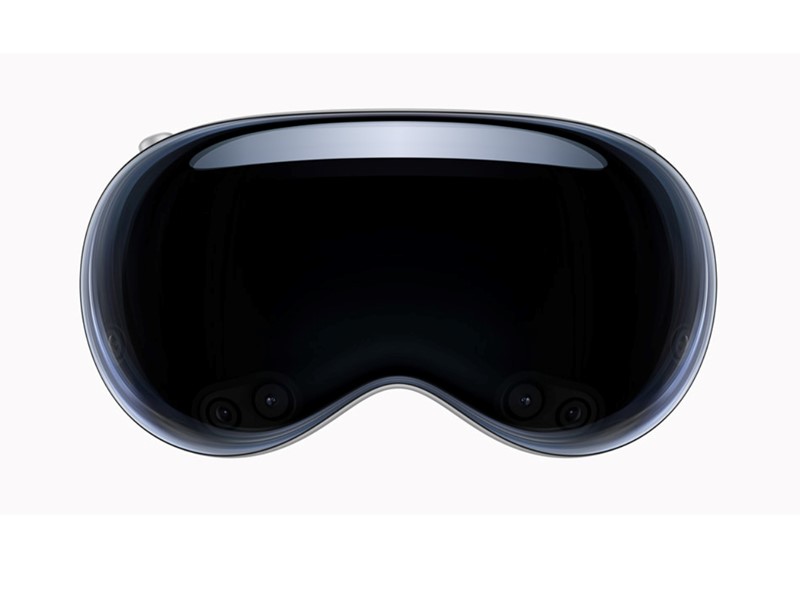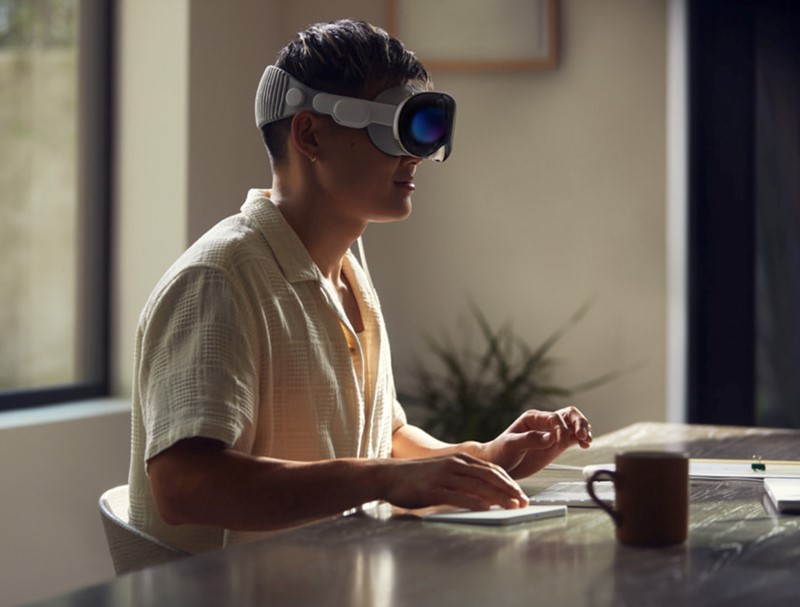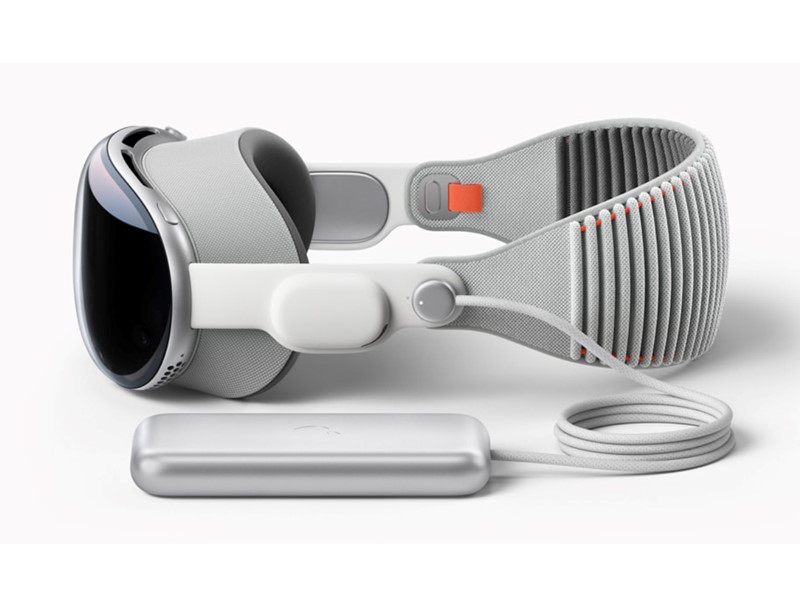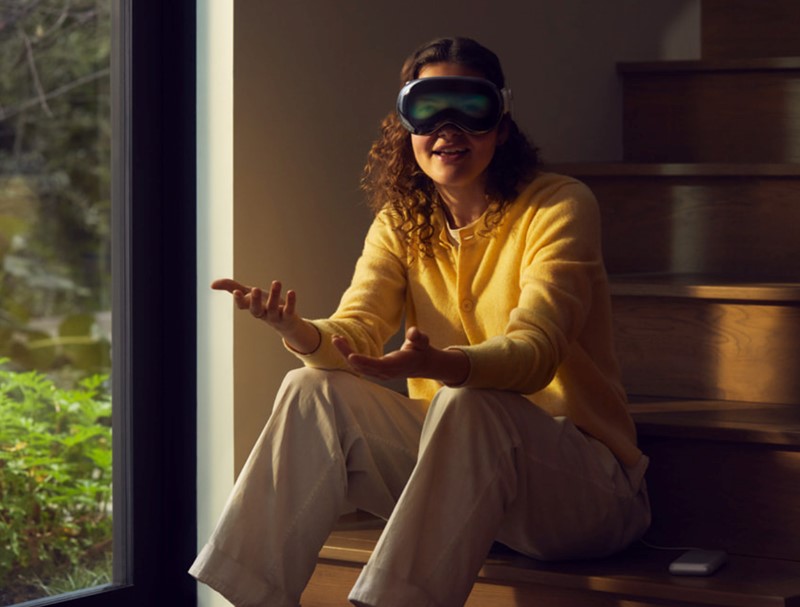Apple used its Worldwide Developer’s Conference (WWDC23) last night (Monday 5 June) to unveil its augmented-reality headset, called Apple Vision Pro, hailing it as a “revolutionary spatial computer”.
The Apple Vision Pro headset is designed to blend digital content with the physical world, introducing a fully three-dimensional user interface controlled by natural, intuitive inputs – the user’s eyes, hands and voice.
Vision Pro features an ultra-high-resolution display system with 23 million pixels across two displays, driven by custom Apple silicon in a dual-chip design.
Apple also introduced another operating system for the headset, visionOS, calling it the world’s first spatial operating system. Vision Pro is designed to let users interact with digital content in a way that feels like it is physically present in their space, so they have an infinite canvas for apps that go beyond the boundaries of a traditional screen display.
The headset is intended to offer the user infinite screen real-estate, with access to their favourite apps, multitasking features and support for Magic Keyboard and Magic Trackpad. Users can set up their perfect workspace or bring the capabilities of their Mac into Vision Pro wirelessly, creating an enormous, private and portable 4K display.

Image credit: Apple
Tim Cook, Apple’s CEO, said: “Today marks the beginning of a new era for computing. Just as the Mac introduced us to personal computing, and iPhone introduced us to mobile computing, Apple Vision Pro introduces us to spatial computing.
“Built upon decades of Apple innovation, Vision Pro is years ahead and unlike anything created before – with a revolutionary new input system and thousands of groundbreaking innovations. It unlocks incredible experiences for our users and exciting new opportunities for our developers.”
Mike Rockwell, Apple’s vice president of the Technology Development Group, added: “Creating our first spatial computer required invention across nearly every facet of the system. Through a tight integration of hardware and software, we designed a standalone spatial computer in a compact wearable form factor that is the most advanced personal electronics device ever.”
With the two ultra-high-resolution displays, Apple Vision Pro is theoretically capable of transforming any space into a personal movie theatre with a 100ft-wide screen accompanied by an advanced Spatial Audio system. Apple Immersive Video will offer 180-degree high-resolution recordings with Spatial Audio. A line-up of immersive videos for the headset will be available at launch to transport users to new places. Apple is also partnering with Disney to bring its streaming service, Disney+, to the Vision Pro. Disney CEO Bob Iger said the new headset will enhance the Disney+ viewing experience, adding that users will be able to access the streaming service on the Vision Pro once the product is officially available.

Image credit: Apple
Spatial computing is also intended for immersive gaming, with over 100 Apple Arcade games set for a screen as large as they want, with immersive audio and support for popular game controllers. The spatial experience will also be applicable to photos and videos from a user’s own collection, with iCloud access from the headset to retrieve assets.
The headset’s visionOS has been newly created to support the low-latency requirements of spatial computing. The new three-dimensional interface is intended to make digital content look and feel present in a user’s physical world. By responding dynamically to natural light and casting shadows, it can help the user understand scale and distance. Apple Vision Pro also introduces a new input system controlled by a person’s eyes, hands and voice, whereby users can browse through apps by looking at them, tapping their fingers to select, flicking their wrist to scroll, or using voice to dictate.
In hardware terms, Apple Vision Pro draws on designs and technologies developed for Mac, iPhone and Apple Watch, with the Vision Pro notably featuring a Digital Crown similar to Apple Watch, which on the headset will enable the user to control how present or immersed they are in the virtual environment.
Apple Vision Pro will be made of a singular piece of three-dimensionally formed and laminated glass to create the optical surface that acts as a lens for the wide array of cameras and sensors needed to blend the physical world with digital content.
The glass flows into the custom aluminium alloy frame that gently curves around the user’s face, while the modular system allows for a tailored fit to accommodate a wide range of people. The Light Seal is made of a soft textile, with a range of shapes and sizes, flexing to conform to a user’s face for a precise fit. Flexible straps ensure audio remains close to the user’s ears, while a Head Band is three-dimensionally knitted as a single piece to provide cushioning, breathability and stretch. The band is secured with a simple mechanism, making it easy to change to another size or style of band.

Image credit: Apple
The Vision Pro headset will feature an ‘advanced Spatial Audio system’ to create the sensation that sounds are coming from all around in the environment in which the user is immersed. Two individually amplified drivers inside each audio pod deliver the spatial audio.
The headset will also have a high-performance eye-tracking system that uses high-speed cameras and a ring of LEDs, which project invisible light patterns onto the user’s eyes for responsive, intuitive input.
A slim battery is connected to the headset by a cable, providing up to two hours from the external battery pack. The headset is designed to be used all day when plugged in to the mains.
The headset’s ultra-high-resolution display system is built on top of an Apple silicon chip and uses micro-OLED technology to pack 23 million pixels into its two displays – each the size of a postage stamp – with wide colour and high dynamic range. The display also uses custom catadioptric lenses for very high sharpness and clarity. Zeiss Optical Inserts will be available for users with vision correction needs.
A unique dual-chip design will feature Apple’s M2 chip paired with the new R1 chip to process the input from the Vision Pro’s 12 cameras, five sensors and six microphones. This is all intended to keep the content appearing smoothly in real time. The R1 chip streams new images to the displays within 12 milliseconds – eight times faster than the blink of a human eye.

Image credit: Apple
The Vision Pro headset also features EyeSight, an innovation to help users stay connected with those around them in the real world. When another individual approaches a person wearing Vision Pro, the device feels transparent, allowing the user to see the person clearly while also displaying the user’s eyes to the other person. While a user is immersed in an environment or using an app, EyeSight gives visual cues to other people about what the user is focused on. The Eyesight solution could help integrate the virtual-reality headset more easily into social settings, whether it is being used for work or pleasure.
Apple Vision Pro will start at $3,499 and will be available early next year from apple.com and at Apple Store locations in the US. More countries will follow later in 2024.
Apple also used its WWDC23 keynote to unveil a new 15‑inch MacBook Air featuring the M2 chip and a six-speaker sound system; two upgraded professional Macs, the Studio and the Pro, introducing the M2 Max and M2 Ultra chip, completing the entire Mac computing lineup to Apple silicon; new operating systems for its mobile and wearable gadgets in iOS 17 and watchOS 10, and previewed Sonoma, the next iteration of macOS.
Sign up to the E&T News e-mail to get great stories like this delivered to your inbox every day.
- SEO Powered Content & PR Distribution. Get Amplified Today.
- PlatoData.Network Vertical Generative Ai. Empower Yourself. Access Here.
- PlatoAiStream. Web3 Intelligence. Knowledge Amplified. Access Here.
- PlatoESG. Automotive / EVs, Carbon, CleanTech, Energy, Environment, Solar, Waste Management. Access Here.
- BlockOffsets. Modernizing Environmental Offset Ownership. Access Here.
- Source: https://eandt.theiet.org/content/articles/2023/06/apple-unveils-the-first-spatial-computer-the-vision-pro/



